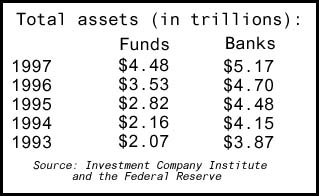|
Mutual-fund madness
|
 |
March 26, 1998: 1:32 p.m. ET
For the first time, assets in funds are expected to surpass bank assets
|
NEW YORK (CNNfn) - As the Dow Jones industrial average approaches 9,000, the U.S. mutual-fund industry is galloping toward an important milestone of its own.
Market watchers expect assets in U.S. mutual funds to surpass U.S. bank assets within the next few months -- marking a dramatic shift in how people save money and how much faith they have in Wall Street.
"All of us are astounded by the momentum of the mutual-fund industry," said David Hale, global economic strategist with Zurich Kember Investments Inc. in Chicago. "It's an awesome thing to behold."
The mutual-fund business blasted off in 1990, when assets topped $1 trillion for the first time, according to the Investment Company Institute, a mutual-fund research group in Washington, D.C.
That number was astounding enough. But by 1993, mutual fund assets had more than doubled to $2.07 trillion. Four years later, assets doubled again to $4.48 trillion.
A CNNfn Interactive poll this week showed 7 out of 10 respondents rely on mutual funds for the bulk of their portfolios.
Bank assets, meanwhile, have risen modestly from $3.87 trillion in 1993 to $5.1 trillion in 1997, according to the Federal Reserve.
The forces behind the growth
One of the main reasons for the fund boom is the growth of the 401(k) over traditional pension funds, said Scott Pape, vice president and portfolio manager of Loomis Sayles in Chicago. Pape, a former fund manager, oversees $3 billion in institutional accounts.
"Baby Boomers are saving more and spending less," Pape said. "Most folks don't think they'll see much in the way of Social Security dollars, so there's a big need for retirement savings."
The industry also did a good job building name recognition and making it easy for people to invest, said Russ Kinnel, head of equity research at Morningstar Inc., a mutual-fund tracker in Chicago.
Fund companies like Fidelity Investments, T. Rowe Price and Vanguard Group are household names that people trust, Kinnel said. Investors can often call fund companies around the clock, and usually redeem their shares within a day.

Low interest rates and less competition from alternative investments like real-estate ventures were other factors that propelled the fund industry, said Michael Lipper, president of Lipper Analytical Services in New York.
"I've been surprised how long (the fund industry) has been going up," Lipper said.
But the banking industry isn't worried about the competition. Michael ter Maat, senior economist at the American Bankers Association in Washington, D.C., argued many banks manage or sell funds.
"Banks are participating in the growth of mutual funds," ter Maat said.
Banks are doing a good job marketing themselves -- but they have a much wider range of products to pitch, he said.
The good side
The advantage for fund investors is they can rely on a fund manager's knowledge and diversify at less cost, said Ralph Wanger, chief investment officer at Wanger Asset Management and Acorn Investment Trust in Chicago.
"Amateurs think they're doing well," Wanger said. "The Beardstown Ladies are a good example."
The Beardstown Ladies, famous for top-selling do-it-yourself investment guides, recently admitted they overstated returns.
"I've seen mutual funds grow from a profession to a business to an industry," Wanger said. "There is no sign whatsoever that there's anything to stop the growth. There's more funds being started every day. The industry is getting more and more sophisticated. At this point it's up, up, up."
Acorn has three funds with assets of $5.5 billion. Acorn International Fund, started in 1992, has $1.7 billion in assets. Acorn Fund, which Wanger started 27 years ago, has $3.6 billion in assets. Acorn USA Fund, started in 1996, has $230 million in assets, Wanger said.
Hot funds
Overall, domestic stock funds have led the meteoric growth in the industry, Lipper said.
Funds that invested in the top 100 companies in the S&P 500, such as Vanguard's Index Trust 500 Portfolio (VFINX), did especially well, Lipper said.
While Morningstar doesn't track funds by asset growth, Kinnel mentioned two other fast risers. One is PBHG Growth Fund Inc. (PBHGX), up from $3 million in assets in 1992 to $5.4 billion this year, he said. Another, Janus Worldwide Fund (JAWWX) had $208 million in assets in 1992 and $11 billion this year.
Meanwhile, the bigger the industry gets, the more it helps the worst-performing fund companies, Kinnel said. Banks buy the bad performers and put more-disciplined institutional money managers in charge. For example, Mellon Bank's purchase of Dreyfus Funds in 1994 helped give the funds better direction, he said.
The bad side
But big isn't always better. The bigger the fund, the greater the challenge for a manager to beat the market, Wanger said. If a fund gets too big, it performs like an index fund.
Another challenge of a giant fund industry is it gets harder for managers to find good bargains, Lipper said.
"You're more vulnerable to surprises," Lipper said. "Any bad news could have a dramatic effect."
And as fund companies offer a wider range of services, costs will rise, Kinnel said.
"Fund companies tend to put the service costs into the basic expense ratio even if you're not getting a lot of the services," Kinnel said. "As they try to become all things to all people, it may drive up the cost for people who don't want the extra services."
What about a market correction?
Of course, mutual funds are having such a heyday because the U.S. stock market has been on a stellar ride. That leads to the scary question: what happens to mutual funds in a down market? The industry hasn't had such a challenge in 10 years, Wanger said.
Wanger acknowledges fund investors have been spoiled. Investors sooner or later will have to face living with lower returns, he said.
"The returns we've had for the last three years are not sustainable," Wanger said. "It's not going to be Christmas every day."
-- by staff writer Martine Costello
|
|
|
|
|
 |

|

